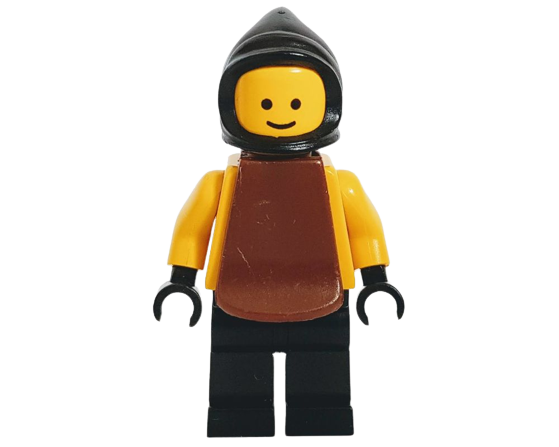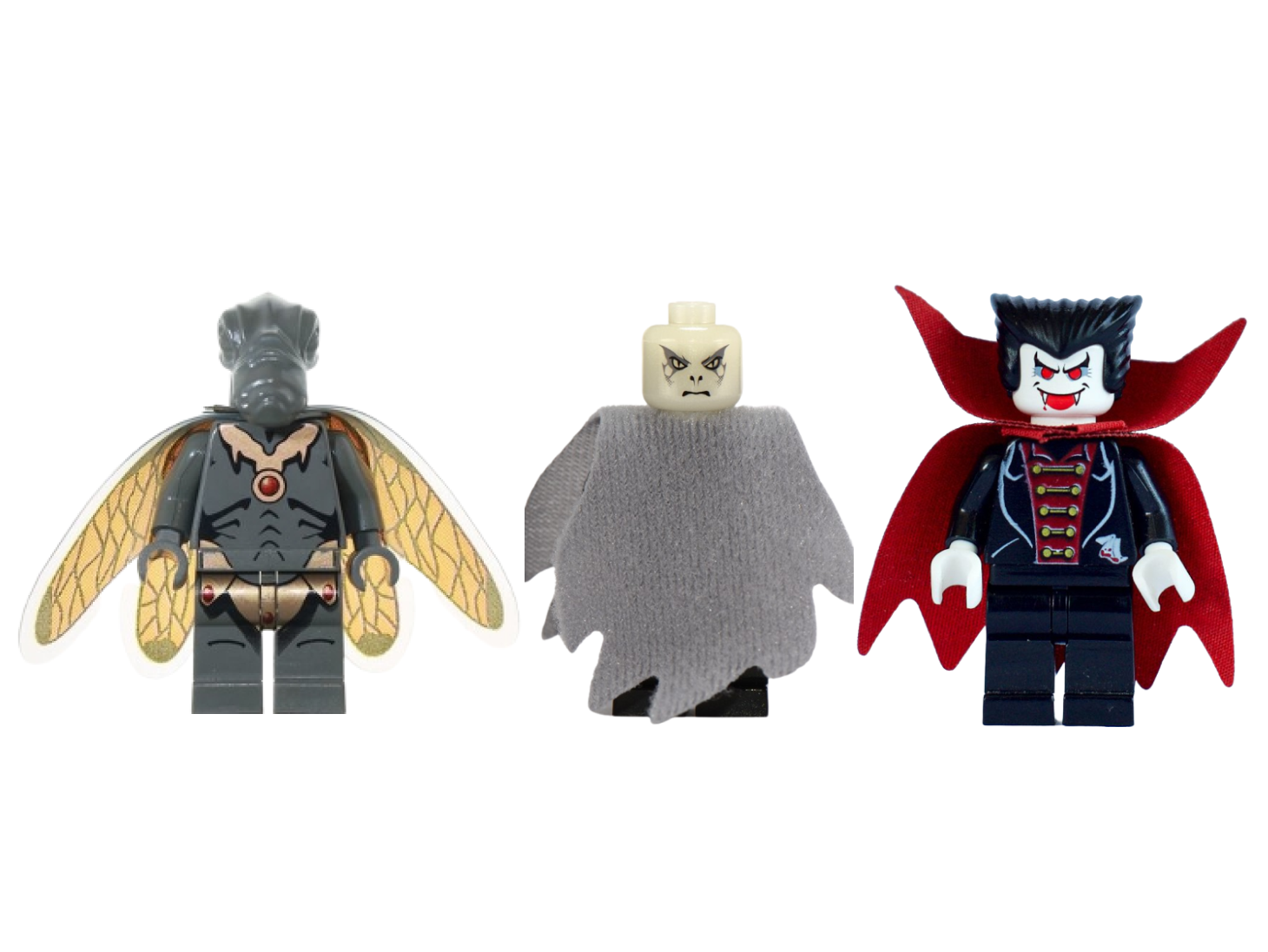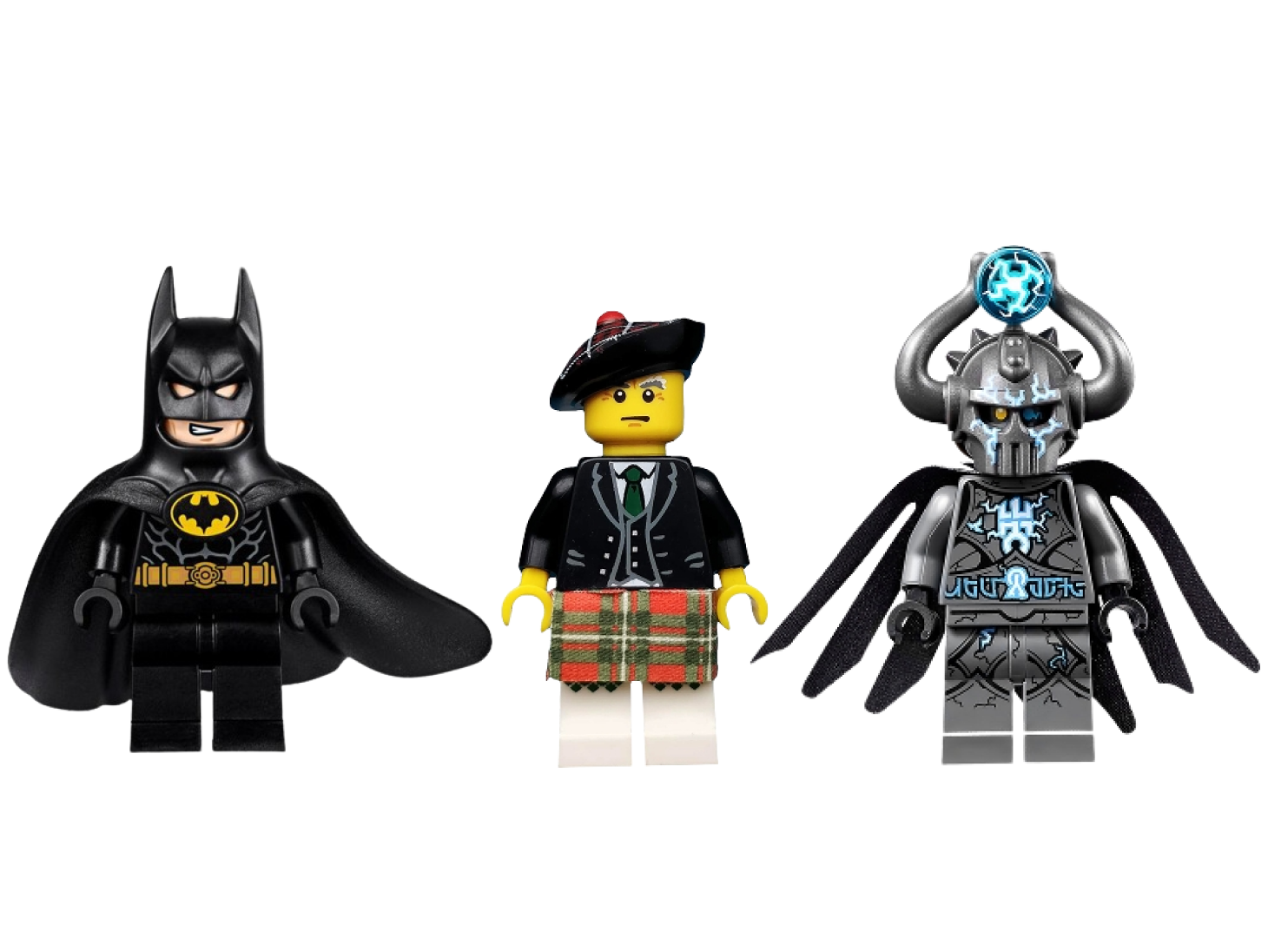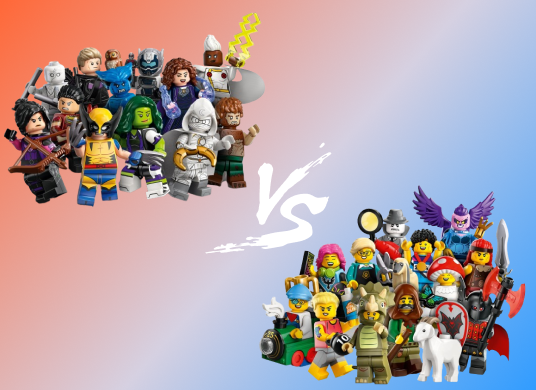LEGO Minifigure Capes: A Short History
1st November 2023
Capes are a commonplace minifigure accessory that adds an extra dimension and can bring interest to even the most mundane minifigure. In this article we take a look at the history of the LEGO minifigure cape and how it has evolved over the years.

1980s
1984 was the year LEGO minifigure capes were born, with the very first ones being plastic. Growing up I never knew what the part was supposed to resemble and I doubt (I hope) I was alone here, as they certainly weren’t the most obvious accessory.
The cloak piece appeared in that year’s wave of Castle sets in black, red, blue, and brown. The brown version only appeared in the 6040 Blacksmith Shop, with the part being used to depict the blacksmith’s apron, which was some rather clever part usage I must say.
LEGO stuck with plastic capes throughout the 1980s and into the early 1990s, with them featuring in 30 different sets before they were axed.

Left to right: Royal Knights King (cas060), Achu (adv001), Dragon Master (cas001)
1990s
In 1993 LEGO began producing its first fabric pieces. That year they launched the Dragon Knights subtheme of Castle, where the main protagonist was the Dragon Master. He appeared in many of the subtheme’s sets, and on three occasions came with a cloth cape bearing a motif depicting the classic LEGO green dragon. The cape had a single neck hole for attaching to the minifigure and rounded ends.
For so long LEGO sets had been exclusively plastic, so getting a second material must have been a game changer. LEGO also didn’t stop at capes, as cloth flags also started appearing.
However, they were far from common. The one-holed rounded cloth cape introduced in 1993 was only given one other variant. This appeared in the 6090 Royal Knight's Castle from 1995, on the shoulders of the Royal Knights king. The dragon motif was replaced with a lion motif and the cape was in the red and white colours of the faction.
In 1999 we got what is still one of my favourite LEGO capes of all time. The Adventurers theme, which had been running since 1998, released a wave of Jungle sets. Achu was the guardian of ancient treasures and sported a tribal style cape with a striking red, green, and yellow colour scheme and central motif. It topped off a rather exceptional looking minifigure.
Up until the late 1990s, there had been limited scope for LEGO capes, as it was only the historical themes that provided grounds to use them. However, LEGO Star Wars was born in 1999 where there were Jedis and Siths aplenty, most of which required some kind of cloak.
By then, the standard LEGO cape had evolved into a two-holed piece made of a stiffer, paper-like material. These were not without criticism as they had a very static position and creased and frayed over time. Any collector will know that the only way to keep these in perfect condition is to never put them on your minifigure.

Left to right: Geonosian (sw0078), Voldemort (hp069), Vampire (hrf005)
2000s
The introduction of LEGO Harry Potter and DC Super Heroes meant that many more capes started finding their way into sets during the 2000s. Most continued to be made from the stiffer fabric, with only a couple of exceptions. This included dementors, Lord Voldemort, and Lucius Malfoy, who received a felty grey cloak between 2004 and 2005. The reason for this was that the characters needed a cloak piece that could hang down the minifigure on both sides, which is something the more rigid, papery material could not achieve.
The Harry Potter theme gave us some great capes in the beginning, as the standard cape used for early versions of Harry, Ron, and Hermione were printed with a star pattern that looked fantastic. However, sadly these were phased out and replaced with unprinted ones.
Notable capes from this decade include the first dual coloured cloak, which appeared on Lando Calrissian, a transparent plastic cape used to portray the wings of a Star Wars Geonosian, and the first single shoulder cloak used for Sand Troopers. LEGO was also beginning to experiment with the cape blueprint, so we began to get some more interesting shapes. This included a combined cloak and collar piece used for vampires and other villains.

2010s to Present
Left to right: Batman (sh607), Bagpiper (col102), Lord Krakenskull (nex098)
As we moved through the 2010s, LEGO cloaks began to take on much more variety, with many different lengths, shapes, and effects being used. LEGO’s ever growing portfolio of characters demanded that the company be creative with the form a cape could take on.
In search for the perfect cape, LEGO also decided to change up the material once again. This time they switched to a spongy, stretchable material, which was more flexible, looked and felt more cape-like, and allowed caped minifigures to be put into vehicles without fear of creasing. They were far from a silver bullet though, as the thicker material led to more separation between the minifigure’s neck and torso and it tended to bunch up around the neck. These cloaks debuted in the Justice League sets released at the beginning of 2015.
2019 saw the first rubberised cape piece, which was used to depict Michael Keaton’s portrayal of Batman in the 1989 Batmobile (76139). Being rubber, it had minimal flexibility but effectively conveyed the superhero’s sweeping cloak very effectively. Being much more costly to manufacture than a simple cloth cape, the rubber version has only been used for a couple of other minifigures to date.
Other memorable capes from this decade, of which there are many, include the seven pointed cape belonging to Lord Krakenskull, the shiny, gold capes used for the party-going Batman minifigures in the 2017 LEGO Batman Movie sets, and King Magnifico’s (dis148) iridescent, star-patterned cloak. The Collectible Minifigure series also introduced the first minifigure cloth skirt on the Bagpiper. Personally, I don’t know where I sit with minifigure skirts as they feel a bit unLEGO-like to me. However, they do add a greater level of realism and accuracy so I can see their place in the LEGO world.
A few thicker fur-like capes were also used, usually minifigures inhabiting colder climes, such as the Hun Warrior.
I think most LEGO fans will agree that LEGO capes are a great addition to a minifigure. With all the developments that have taken place over the past few decades, we’re excited to see where the LEGO cape goes next.

Graham is a passionate LEGO collector, who has a penchant for the Castle, Pirates, and Western themes. You can usually find him monitoring the latest developments and giving his opinion on what's hot and not in the LEGO world.
Comments
Affiliate links
If you found this site useful please consider supporting Brick Ranker by using the affliate links below when purchasing LEGO.
Latest reviews

Which LEGO Collectible Minifigures Are Better - Licensed or Non-Licensed?
A short while ago, we brought you an article looking at whether LEGO Collectible Minifigure (CMF) series are getting better…

Every Comic-Con Exclusive Set Ranked By Rarity
Think Comic-Con, and if you're a LEGO collector, you'll undoubtedly think of the exclusive, and now insanely expensive, minifigures. Getting…

The Bricklink Designer Program - Everything You Need To Know
The latest series of projects fighting for production under the Bricklink Designer Program will go head-to-head tomorrow at 8am PT…